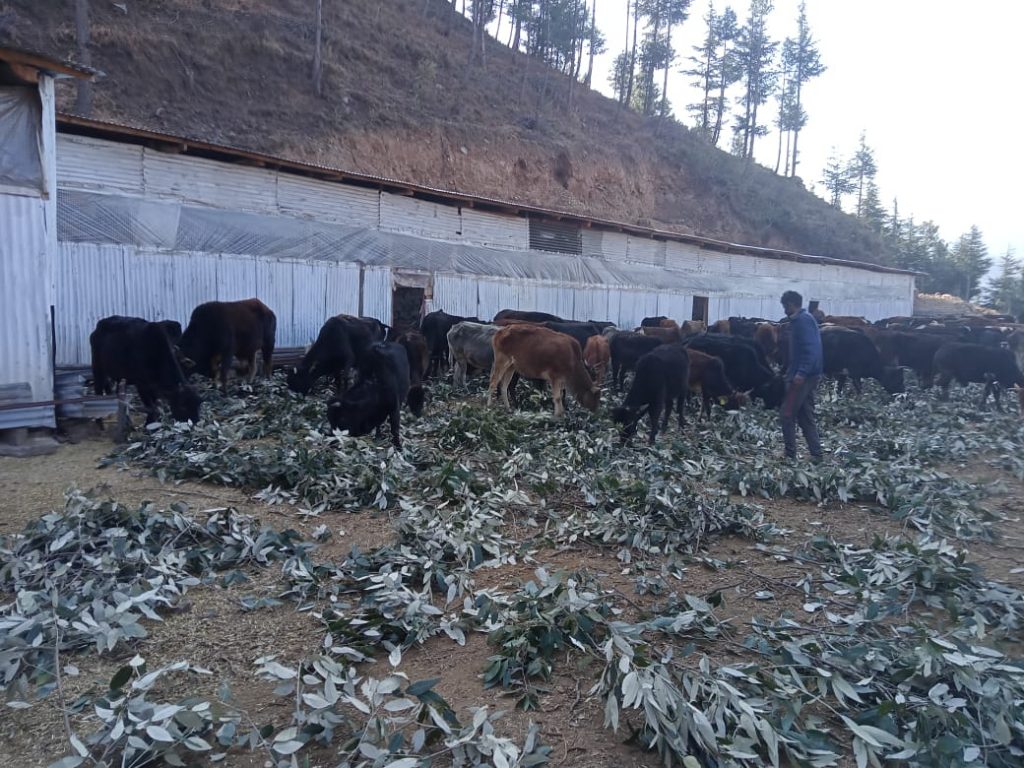Stray Cattle Problem
Cows are bred and domesticated for economic benefit, and the moment they stop producing milk, they become a liability to the average owner. Increasing mechanisation has made bulls almost redundant economically.
Presently, as per our estimate, the cost to buy fodder for an adult animal is around Rs. 5,000 per month. The average middle and lower income group cannot afford to house an unproductive animal — and these animals, more often than not, end up on the street. A 2015 government figure estimated that Himachal Pradesh has around 31,000 stray cattle.
Stray cattle not only damage crops, but also can cause traffic accident. Besides, on a humanitarian note, the animals that spend their lives earning money for us deserve a happy last chapter of their lives. By ending up on the street, due to the lack of fodder, they end up eating waste materials like plastic, which ultimately slowly kills them.
The government of HP is working towards solving the problem, and besides building its own shelters, they provide Rs. 500 per cattle per month to gaushalas housing stray and abandoned animals; but since the problem is immense, there is a need for participation of private enterprises, which are generally more efficient, to help solve this problem.
Dr. YS Parmar Gausadan
We started Dr. YS Parmar Gausadan in mid 2020, to help house stray cattle and to work on a long term solution for this problem. Run by our society Him Gau Sanrakshan Samiti (himgau.org), this cow sanctuary houses around 170 cattle, and is located near Village Sanora, Rajgarh in district Sirmaur, HP. This project is a brainchild of Dr. Rajender Attri, a retired college professor of Political Science, and it was constructed with his own life savings.

Built in the hills, our establishment tries to maintain the health and wellness of the animals by utilising novel approaches to the traditional gaushala model. The shelter is constructed of local materials, and has a capacity to house around 180 cattle. We try to ensure that the animals get the best possible diet at the exceptionally limited budget we have at our disposal.

During summers, when grass is abundant, most of our cattle are taken to graze in nearby pastures. The cattle roam free and eat to their heart’s content during the day and return to the shelter in the evening. Those that are too young, or too old, or infirm stay at the shelter, where there’s ample of space and food. In winters we rely on purchasing fodder, and those few months are relatively harsh, from a financial perspective.

As fodder, we rely on Wheat Straw (Turi), Corn Silage, and leaves of Ban Oak trees. We supplement this with high quality cow feed, which being expensive, is only given as a delicacy.
We constantly try to look for alternative food sources, and presently, we have immediate plans to start giving the animals Rice Bran (Chokar), Mineral Mixture, and Jaggery(gur) as a supplement. In the future, we plan to grow fodder on-site, to supplement the diet of the animals and to lower the costs.
We try to raise funds via online donations through our website, and by engaging with crowd funding platforms like Donatekart.
Challenges
The primary challenge of any gaushala/cow sanctuary housing stray and dry (non milk producing) cattle is to raise funds for the fodder. The primary reason why these animals end up in gaushalas is that they don’t provide economical value to even cover their own food. We sell cow dung products to raise funds, but that is not nearly enough to match our expenses. The sharp rise in the fodder costs in the preceding few months have increased the financial stress on our establishment, and on other gaushalas as well.
Beside fodder, we also incur massive expenses on labour costs, repairs, and improvement of infrastructure. Since we take our animals outside, salaries and wages form a major part of our expenses.
Since gaushalas are always in dire need of funds, we have but little to spare on medical expenses. Presently, we rely on the government to provide these animals with medical care, but we are working on raising funds to have an in-house doctor and a pharmacist.
With increasing inflation and the rise in the fodder prices, gaushalas need to look for innovative solutions to raise money. We are committed to be a part of solution to the problems of stray cattle, and we are constantly looking for ways to improve our establishment.
There is a need for a centralised platform to ensure that people willing to assist financially should be able to connect to their nearby gaushalas directly. Gaushalas that are located near cities can get donations of fodder from patrons, but those located in secluded areas don’t have this luxury.
There is also a need to develop an efficient distribution and vending platform to sell products like manure produced at gaushalas. A singular point of sale, and a novel “brand image” would help promote organic farming, as well as fetch some much needed funds for gaushalas.
There is also a need for development of a long term plan to improve the profitability of gaushalas to invite more private interest. The problem of stray cattle requires public and private participation, and no solutions can be achieved without active role played by both these parties.
The problem of stray cattle is here to stay, at least in the near future. The economic benefit offered by these animals when they are healthy is considerable and that would always make them a part of a farmer’s family, but the economic liability of these animals when they become non-productive would always tempt owners to abandon them on the street.
There is a dire need of making this sector more profitable to invite investor interest, and to ensure building of a system in which the animals are sent directly to gaushalas when they are old, rather than being abandoned on the street.


